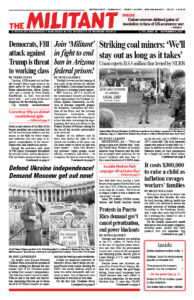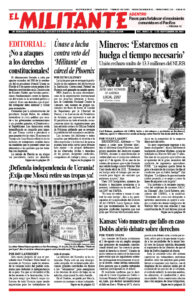UNITED NATIONS — “The first program for equality that Cuban women won was the revolution itself,” Teresa Amarelle, general secretary of the Federation of Cuban Women (FMC), told the Militant during an interview here in March.
“The struggle isn’t over today, of course. We still confront many challenges,” she said. “But it was the revolution that truly allowed women to spread their wings.”
Amarelle cited some of the advances for women in the course of Cuba’s revolutionary movement, led by Fidel Castro, that overthrew the U.S.-backed Batista dictatorship in 1959, established a workers and farmers government and carried out the first socialist revolution in the Americas. Millions of working people, including women, were transformed as they fought to transform society.
Those changes began among the combatants of the Rebel Army — including the Mariana Grajales Women’s Platoon, initiated by Castro — during the struggle to overturn the Batista tyranny. After the 1959 victory, the determination of women to participate in the revolution and the support they received from Castro above all, broke down barrier after barrier inherited from capitalist society.
Women were part of leading the agrarian reform that transformed the countryside. They joined the militias and Revolutionary Armed Forces, and helped lead the medical corps. They were a majority of the 250,000 volunteers who in 1961 taught 700,000 Cubans, in their majority women, to read and write, wiping out illiteracy in one year. In 1960 they founded the Federation of Cuban Women, forged in the heat of these mobilizations.
In the course of two short years, 1961-63, they brought 21,000 young women from rural areas to Havana, with their parents’ permission, to study at the Ana Betancourt School for Peasant Women. They learned to read and write, acquired basic knowledge of nutrition and hygiene and learned to make clothes for themselves and their families, as well as other job skills. They were introduced to the theater, ballet and other art forms.
As their self-confidence grew, they began to see themselves differently and returned to their homes, sharing what they learned and helping bring the revolution to the countryside. Women also began breaking into “nontraditional” jobs, driving taxis and tractors, getting hired as bank clerks and more.
At the initiative of Vilma Espín, a former Rebel Army combatant and longtime president of the Federation of Cuban Women, the first child care centers were set up in 1961.
Maternal and infant death rates fell as the free public health system was established and the FMC educated women on reproductive health. Deaths and mutilations from back-alley abortions became a thing of the past as the health care system provided safe, reliable contraception and abortion was made available in hospitals, carried out by qualified medical specialists under sanitary conditions.
Women have taken part in Cuba’s internationalist missions around the world from the very first days of the revolution. They were among the doctors who served in Algeria in 1963 and the volunteers who in 1966-67 fought side by side with Che Guevara in Bolivia. Two Women’s Antiaircraft Artillery Regiments helped defend Angola’s independence from invasions by the South African apartheid regime in the 1970s and ’80s. And medical brigades have helped combat the COVID pandemic in dozens of countries since 2020.

